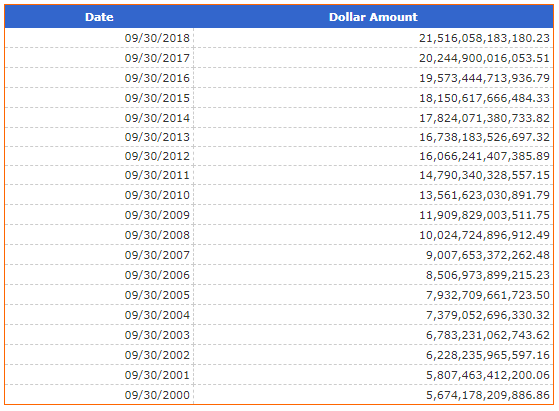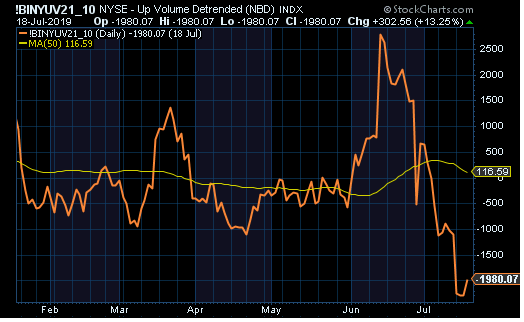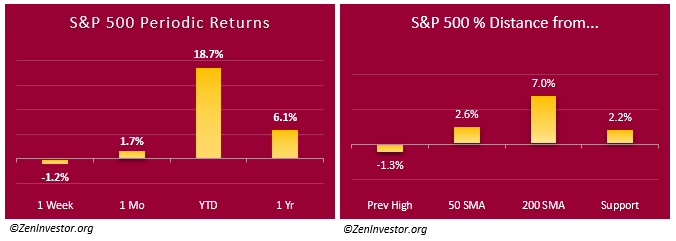What happened last week.
What we're watching for next week.
How high can the market go? 3100 on the S&P seems doable. The Wavers are forecasting 4000-4200. But here's the thing: price targets aren't very helpful because everybody has a different one and you can't know ahead of time which will be the closest to what actually happens.
The more relevant question is can the Fed keep the rally going by cutting rates? For a while, probably, but eventually the economy will peak and the Fed won't have any rate-cutting bullets left in the chamber.
Then there's the problem of the ever-increasing mountain of debt on the books of the US Treasury and corporate America. Consumers have done a good job of paying down debt since the last recession but Uncle Sam and Corporate America have not.
We're headed for another debt ceiling showdown in congress, and I'm going to go out on a limb and predict that the two sides won't be willing to do the right thing for the country and there will be yet another government shutdown.
Chart of the Week - U.S. National Debt
This table is from the U.S. Treasury Department. It shows the total indebtedness of the USA going back to 2000. This period includes 4 presidents - Clinton, Bush, Obama, and Trump.
Clinton was the only one who managed to balance the budget so that no additional debt was created in 2000. He was able to accomplish this feat by working with republicans, who at that time were the party of fiscal responsibility. Bipartisan deal making at its finest.
Unfortunately, our fearless leaders in congress today have little to no interest in fiscal responsibility. I expect the debt to keep rising until someone steps up and says "enough already."
The trouble with carrying a large debt load, as every homeowner, student, and credit card holder knows is that you have to pay interest on that debt. Right now interest rates are low enough to make this a reasonable task.
But our national debt is so large now that low rates alone can't save us from what's coming - higher rates, higher inflation, drastic budget cuts, and possibly a return to Stagflation like we saw in the 1970s.
Chart 2. Up Volume minus Down Volume
This chart tracks the volume of trading that happens on upticks vs. downticks. It's one of several measures of momentum we follow. You can see that, although the market is making new highs the down volume is swamping the up volume.
Chart 3. S&P periodic returns.
The market is still grinding higher. The numbers in these two charts are healthy. Stay invested but have your Plan B ready for the turn.
Chart 4. Early look at Q2 earnings
Earnings growth was essentially flat in the March quarter and the expectation is for a -2.3% decline in the June quarter. Earnings growth is expected to be in negative territory in Q3 as well (down -1.9%), with positive growth expected to resume only in the 4th quarter of the year. If that doesn't materialize the market will probably weaken.
Final Thoughts
Last week was a big nothing in the market. Next week I'll be watching the Fed, the escalating tensions with Iran, the testimony of Robert Mueller, and the continuing battle of words between Trump and Xi.
If you want more info about how to set up a solid Plan B, see my articles on the subject here and here and here.
For a full analysis of the probability of a bear market or a new recession, check out my Monthly Intelligence Report.
As always, if you like what you see, or have suggestions for improving this recap, leave a comment below, or email me at info@zeninvestor.org





Erik: Keep telling you it it all about profits. None of the other things like Iran, Fed, Trump, debt, dollar, matter more than a few days unless profits are significantly affected.
Remember: A 2% 10 year treasury is equivalent to a 50 PE in the stock market ( 100 price / 2.00 earnings = 50 PE).
If earnings do fall for a number of quarters then market will fall, but with a 2 % 10 year treasury earnings will have to fall quite a bit for a 10 % to 20% fall in the S&P 500.
I am just waiting and watching.